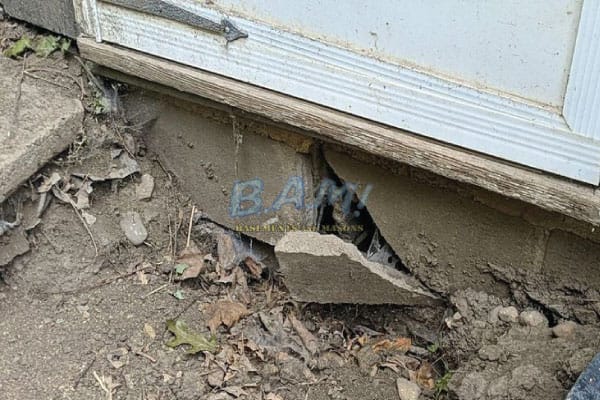The Ultimate Guide To Best Basement Waterproofing
The Ultimate Guide To Best Basement Waterproofing
Blog Article
The 25-Second Trick For Best Basement Waterproofing
Table of ContentsThe Only Guide for Best Basement WaterproofingThe Best Basement Waterproofing StatementsGetting The Best Basement Waterproofing To WorkHow Best Basement Waterproofing can Save You Time, Stress, and Money.5 Easy Facts About Best Basement Waterproofing Explained
AdvantaClean's experienced professionals and technicians will find the water resource. If wall surface or piece fractures are existing, we will inject polyurethane and epoxies into the cracks and seal the concession, avoiding further wetness from going into.
If there's condensation outside of the aluminum foil, you have high moisture in your basement. Repair it with a portable space dehumidifier or a whole-house humidifier system instead of waterproofing products. If the foil has condensation on the inside surface (beside the wall surface), the soil around your home might be normally damp from a high water table or bad dirt drain.
You can waterproof simply your interior walls, which might resolve the problem. Or you can waterproof your outside walls, which is a better wager but more expensive. Right here's the scoop on the various types: These thick layers are cement-like. Once they dry out, they stick permanently to concrete and stonework wall surfaces (Best Basement Waterproofing).
Best Basement Waterproofing Can Be Fun For Anyone
Concrete water resistant coatings can't be used to previously repainted surfaces; examine the label. Recognized as densifiers, they are appropriate only for wall surfaces that have not been repainted or secured.
Yet you brush, roll, or spray it on a lot more heavily one gallon covers just 75 square feet, not the 300 square feet common with standard paint. Water-proof paint is great for DIY application. You can use it over painted surface areas, and paint over it once it's healed (one gallon costs $37).
It can set you back $10,000 to $15,000, depending on the work required. Exterior waterproofing includes digging deep into all around your home fully depth of the foundation wall surfaces, then mounting a water resistant layer or membrane layer topped by drain panels. The panels provide an easy path for water to flow down to an outside French drain at the base of your foundation.
We've all been caught in a storm with no umbrella or raincoat (Best Basement Waterproofing). And it's always a dish for catastrophe: whatever's wet, your hairdo is destroyed, and things are obtaining stuffy. A cellar without waterproofing is sort of like that. Minus the wrecked hairstyle part. Your basement doesn't intend to undergo a downpour without appropriate defense simply as long as you do not wish to.
Rumored Buzz on Best Basement Waterproofing
If you've done your research, you would certainly recognize there are 2 kinds of waterproofing: visit site interior and exterior. It can get confusing what they both mean, which one's a far better financial investment, and what will in fact keep the water out. Do not worry, we assembled this blog to quickly define both approaches for you and go over the pros and cons of each.
Exterior waterproofing is a waterproofing technique that includes securing your home from the outside. It's type of like a moat around a castle. It entails excavating a trench around your whole home down to the foundation (about 8 to 10 feet down). The structure wall surfaces are then cleansed, secured, and covered with a water resistant membrane layer or sealer.
Facts About Best Basement Waterproofing Uncovered
It's a much more engaged procedure that needs digging up your yard, which is expensive and taxing. Outside waterproofing includes getting rid of everything surrounding directory your home, including verandas, driveways, walkways, landscape design, air conditioning devices, decks, and so forth. If any of the work was done inaccurately and water is still entering your basement, there isn't much you can do to fix or fix it.
Inside basement waterproofing involves waterproofing from the within. Any water that leaks into your cellar is rerouted before it touches your floor. It's type of like putting on a raincoat under your garments. It entails 2 points: a water drainage track and a sump pump. It works by securing the inside of your basement wall surfaces and floorings so water that tries to get in is transported out via a sump pump.
It's a reliable approach to waterproof your cellar. The disadvantage of interior basement waterproofing primarily has to do with the setup procedure.
The Facts About Best Basement Waterproofing Uncovered
To conclude, outside and i thought about this indoor cellar waterproofing are both reliable techniques of shielding your home from water damage. Outside waterproofing develops a barrier that protects against water from entering your home, while interior waterproofing reroutes water that does enter your home. And it is necessary to note that exterior waterproofing is an expensive and disruptive installation process when compared to interior waterproofing.
Whichever method you pick, make sure you pick a reliable and trustworthy service provider for the task. If you have any type of inquiries concerning basement waterproofing, please get to out to us.
You can fill in our type below, start a chat in the bottom right-hand edge, or call us at 1-800-827-0702.
Report this page